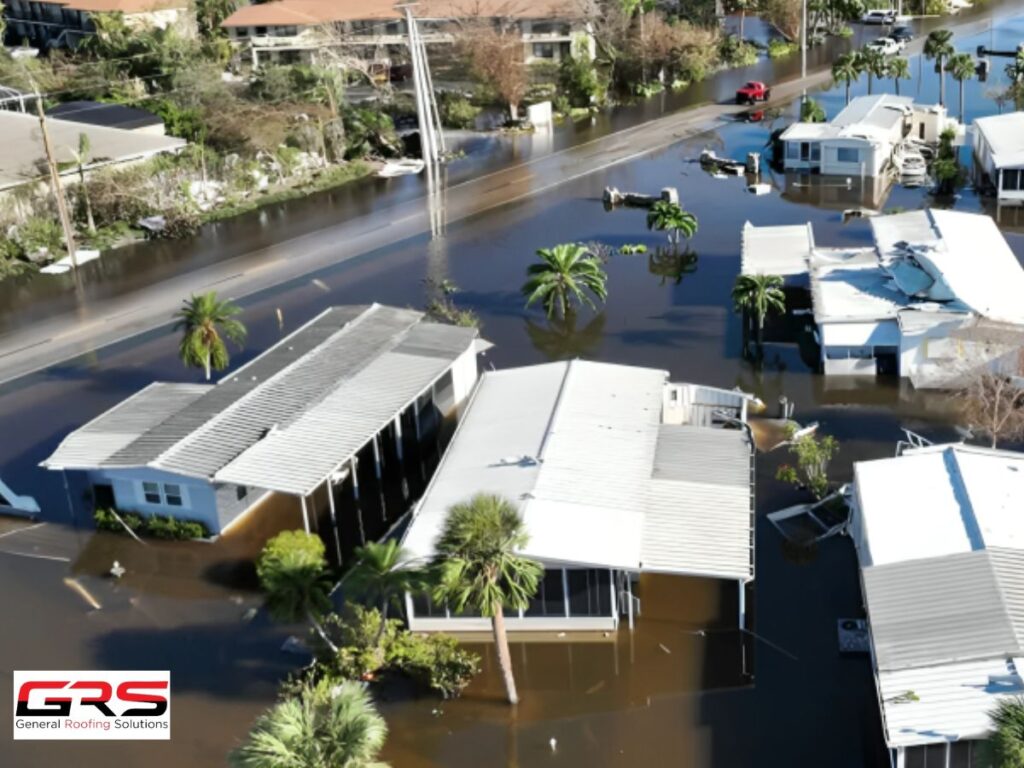South Florida has faced immense challenges in the aftermath of Hurricanes Helene and Milton, which made landfall in late 2024. These powerful storms brought widespread devastation, causing billions of dollars in damage to homes and infrastructure. Among the hardest hit were residential roofs, which faced high winds, rain, and debris. In this article, we’ll explore the impact of hurricanes on roofing systems in South Florida, the types of damage sustained, and the essential measures homeowners can take to protect their roofs from future storms.

Hurricanes Helene and Milton: A Wake-Up Call
Hurricanes Helene and Milton left an undeniable mark on South Florida. Helene, the more powerful of the two, caused $225-250 billion in damage, while Milton, which made landfall a few weeks later, added another $160-180 billion in destruction. These hurricanes brought wind speeds of over 120 mph and dumped more than 18 inches of rain in certain areas, creating perfect conditions for severe roof damage.
Milton’s tornados compounded the destruction, with 45 confirmed tornadoes adding to the chaos. Homeowners were left with roofs that had been torn apart by high winds, punctured by flying debris, or flooded due to leaks.
The Most Common Types of Roof Damage
- Wind Uplift and Material Loss
The high winds from hurricanes Helene and Milton ripped shingles, tiles, and metal panels from homes, leaving many roofs exposed to the elements. When roofing materials are compromised, the entire structure becomes vulnerable to water damage.
- Debris Impact
Flying debris such as branches and outdoor items became projectiles during the storms, causing significant roof damage. Roof punctures from debris allowed rainwater to pour into homes, exacerbating the damage and leading to mold, rot, and interior destruction.
- Water Intrusion and Leaks
Heavy rainfall overwhelmed many roofing systems, leading to widespread leaks. Homes with weakened or damaged roofs were particularly susceptible to water intrusion, which can cause long-term damage, including structural decay and unhealthy mold growth.
- Structural Compromise from Tornadoes
The tornadoes associated with Hurricane Milton caused roofs to be ripped entirely from homes. This catastrophic form of damage left many homes exposed, with no defense against ongoing rain and wind. Tornado damage is often the most severe, requiring extensive repairs or even complete roof replacements.
Preparing Your Roof for Future Hurricanes
In South Florida, hurricanes are an inevitable part of life, making roof preparedness essential for homeowners. Here are key steps to help ensure your roof is hurricane-ready:
- Routine Inspections
Annual roof inspections are critical in identifying weak points or existing damage that could worsen during a hurricane. A professional roofer can detect loose shingles, damaged flashing, or weakened support structures, allowing repairs to be made before storm season begins.
- Roof Reinforcement
Reinforcing your roof with hurricane straps or ties can make a significant difference during high winds. These metal connectors help anchor the roof to the structure of the home, reducing the risk of it being lifted or damaged by powerful gusts.
- Use Durable Materials
Investing in impact-resistant materials such as metal roofing or advanced asphalt shingles can help your roof withstand the force of flying debris. These materials are designed to be more durable and longer-lasting, providing better protection during a storm.
- Clear Debris Around the Home
Regularly trimming trees and securing outdoor items can prevent debris from becoming dangerous projectiles. Limiting the amount of potential debris around your home reduces the chances of it damaging your roof during a storm.
Working with Roofing Professionals and Insurance
After a hurricane, repairing roof damage can be costly, and homeowners often find themselves navigating the complexities of insurance claims. It is essential to work with licensed roofing contractors who have experience dealing with hurricane-related damage. Many roofing companies offer emergency services immediately after a storm, providing temporary repairs to minimize water intrusion while waiting for more comprehensive repairs to be completed.
Homeowners should also be familiar with their insurance policies to ensure they have adequate coverage for roof repairs or replacements. Documenting damage as soon as possible after a hurricane and contacting your insurance provider can speed up the claims process and ensure timely repairs.
In Conclusion
Hurricanes Helene and Milton have highlighted the importance of resilient roofing in South Florida. With homes facing relentless winds, rain, and flying debris, roofs are the first line of defense against these powerful storms. Taking proactive measures to inspect, repair, and reinforce roofing systems can make all the difference when the next hurricane strikes. By investing in the right materials and working with professionals, homeowners can protect their properties and families from the devastating effects of future storms.
Need Roofing Services for your home,Contact us for more details


